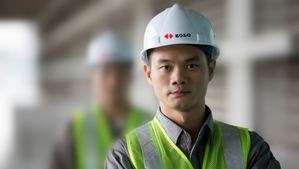Overview
ZOLO ZCLIMB™ ACF100 has the same methodology and features as the ZCLIMB™ ACF50/80 system. Compared with the ACF50/80 system, ZOLO ZCLIMB™ ACF100 is designed to meet the increased requirements such as greater impacts, extra working platforms, or live loads with 10 t lifting capacity per parallel lifting bracket. ( ZCLIMB™ ACF50/80 has 5 t/8t lifting capacity per parallel lifting bracket)
ZOLO ZCLIMB™ ACF100 power source is its hydraulic system, the hydraulic system consists of a hydraulic station, hydraulic cylinder oil pipe, etc. Through the hydraulic system, it can make ZCLIMB™ ACF50/80 formwork frame body and the guide rail to mutual climbing, to make the formwork system climb upward steadily. In the construction process, ZOLO ZCLIMB™ ACF100 climbing formwork works without other lifting equipment, it is easy to operate with rapid climbing speed and high safety factor. ZOLO ZCLIMB™ ACF100 both can climb straight and diagonally, It is the first choice for high-rise building core walls and bridge pylons.

Features
1. ZOLO Z-CLIMB™ ACF100 Self-Climbing Formwork System no need for tower crane repeatedly installed and dismantled, saving manpower, low labor intensity, high degree of mechanization.
2. High safety with multi-floor of operating platform..
3. The formwork panel and the climbing bracket work at the same time, the construction speed is fast to save the cost during the working period.
4. ZOLO Z-CLIMB™ ACF100 Self-Climbing Formwork System components has very high versatility with Zolo other climbing formwork system to help the clients saving more materials investments.
5. ZOLO Z-CLIMB™ ACF100 Self-Climbing Formwork System demolding operation adopts adjusting bracket and horizontal setback device, which is easy to operate and ensures smooth demolding work. ZOLO Z-CLIMB™ ACF100 Self-Climbing Formwork System panel face can be cleaned up in situ, which can save the formwork stacking site and storage cost
6. According to the premise of checking and calculating, it is possible to realize hanging ladder on the main bracket and docking with the construction elevator; carrying the concete placing boom and climbing at the same time.
7. Safe choice, Safe system. Automatic climbing formwork ZOLO Z-CLIMB™ ACF100 is definitely the 'safe' system choice. Its wide, fully enclosed working platforms, the well thought-out access paths and the gapless enclosure all make for a high level of safety at your site. Up to 20 automatic climbers can be raised from one casting section to the next by a single hydraulic unit.
FAQs
1. What is Self-Climbing System Formwork?
Self-Climbing System Formwork is a type of formwork that can ascend the building structure autonomously using hydraulic or mechanical climbing mechanisms. This system is typically used in the construction of high-rise buildings and structures like bridges, towers, and dams.
2. How does Self-Climbing System Formwork work?
The system uses hydraulic jacks or mechanical devices to lift the formwork to the next level once the concrete at the current level has set. The climbing process is usually guided by vertical rails or brackets fixed to the structure, ensuring stability and alignment.
3. What are the advantages of using Self-Climbing System Formwork?
Efficiency: Faster construction cycles due to reduced need for crane lifting.
Safety: Enhanced worker safety as the system provides secure working platforms.
Cost-effective: Lower labor costs and reduced crane time.
Quality: Consistent and high-quality concrete finishes due to controlled formwork conditions.
4. What types of projects are suitable for Self-Climbing System Formwork?
Projects that benefit most from self-climbing formwork include high-rise buildings, towers, skyscrapers, and large-scale vertical structures like silos and bridge pylons.
5. What are the key components of a Self-Climbing System Formwork?
Hydraulic or Mechanical Jacks: For lifting the formwork.
Guiding Rails or Brackets: Ensure proper alignment and stability during the climb.
Form Panels: The actual molds where concrete is poured.
Working Platforms: Provide safe areas for workers to operate.
6. How is safety ensured while using Self-Climbing System Formwork?
Safety is ensured through multiple measures including:
Regular maintenance and inspection of the climbing equipment.
Safety nets and guardrails around working platforms.
Training workers on safe operating procedures.
Use of automated controls to manage the climbing process.
7. Can Self-Climbing System Formwork be customized?
Yes, these systems can be tailored to fit the specific dimensions and requirements of the construction project, ensuring flexibility and adaptability to different structural designs.
8. What are the limitations of Self-Climbing System Formwork?
Initial Cost: Higher upfront investment compared to traditional formwork.
Complexity: Requires specialized training and expertise to operate.
Maintenance: Regular maintenance is needed to ensure smooth operation and safety.
9. How does Self-Climbing System Formwork contribute to sustainability?
By reducing material wastage, enhancing construction speed, and improving structural quality, self-climbing formwork contributes to more sustainable building practices. It also minimizes the environmental impact by reducing the need for cranes and other heavy machinery.
10. What are the typical maintenance requirements for Self-Climbing System Formwork?
Maintenance includes regular inspection of hydraulic jacks and mechanical components, ensuring guiding rails are free of obstructions, checking form panels for damage or wear, and verifying the integrity of safety equipment.
11. How long does it take to set up Self-Climbing System Formwork?
The setup time varies depending on the project size and complexity, but it generally takes several days to a few weeks to fully install and commission the system on a new site.



















